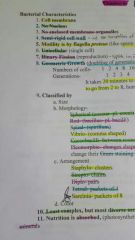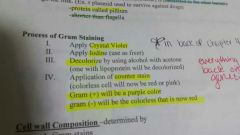![]()
![]()
![]()
Use LEFT and RIGHT arrow keys to navigate between flashcards;
Use UP and DOWN arrow keys to flip the card;
H to show hint;
A reads text to speech;
71 Cards in this Set
- Front
- Back
|
Anyone Van Leeuwenhoek |
Credited with being the first to create a microscope and observe microorganisms |
|
|
Robert Hooke |
Coined the term cell. Credited with cell theory. |
|
|
Cell theory |
All living things are composed of cells |
|
|
Schleiden and schwann |
Credited with cell theory |
|
|
Rudolph Virchow |
Credited with the biogenisis theory |
|
|
Biogenisis theory |
All living organisms are composed of cells and must come from previously living calls |
|
|
Spontaneous Generation |
Life can arise spontaneously from nonliving matter |
|
|
Louis Pastuer |
Disproved spontaneous Generation. Theory by showing that microorganisms are in the air and can contaminate a seemingly sterile solution. But the air doesn't create the microbes
Fermentation was caused by microorganisms
Invented Pasteurization process Microorganisms cause pneumonia |
|
|
Pasteurization Process |
If you heat something like beer milk or wine you can kill most of the bacteria that cause the spoilage. |
|
|
Germ Theory |
Certain microorganisms can cause certain diseases |
|
|
Immunization |
Artificial exposure to a foreign agent to help the body develop a resistance to the agent. |
|
|
Vaccination |
Introduction of a pathogen into the body by artificial means Same as immunization |
|
|
Joseph Lister |
Developed aseptic techniques |
|
|
Mad Cow Disease |
Caused by a protein called prion. This protein is folded the wrong way and causes other proteins to fold the same way |
|
|
Paul Ehrlich |
Developed the first antibiotic substance Called salvarsan which treated syphilis |
|
|
Alexander felming |
Discovered penicillin by accident. The first antibiotics grown for production |
|
|
Watson and crick |
Came up with the model of the DNA, what it looks like, and how it works |
|
|
Pathogen |
Disease causing organism |
|
|
Chemotherapy |
Use of chemicals for treatment of diseases. |
|
|
Synthetic drugs |
Man made drugs |
|
|
Antibiotics |
Substances produced by organisms to kill other organisms. |
|
|
Antibodies |
Proteins produced by lymphocytes in your immune system to fight against pathogens |
|
|
Flora |
Beneficial bacteria that lives in or on you |
|
|
Gram (+) & Gram (-) |
Classification of organisms based on the type of cell wall Used as a way to organize bacteria |
|
|
Organism classification |
How organisms are grouped |
|
|
Taxonomy |
The science of how organisms are grouped |
|
|
Carolus linnacus |
Father of taxobomy |
|
|
Organism classification subgroups |
Kingdom Division Class Order Genus Species |
|
|
Binomial Nomenclature |
THe use of two names to organize or group |
|
|
Whittaker |
3 kingdoms, then later 5 kingdoms |
|
|
5 kingdoms |
1. Animals - tissues/ingest food/multicellular 2. Plants - make own food/photosynthetic 3. Protista 4. Fungi 5. Monera |
|
|
3 domains |
Eukaryotic Prokaryotic Archea |
|
|
Prokaryotic Traits |
No nucleus No nuclear membrane Have ribosomes No ensomembrane Has cell wall and membrane Single circular double stranded chromosomes |
|
|
Eukaryotic |
Enclosed nucleus Doesn't always have a cell wall Has cell membrane Has ribosomes Has ensomembrane system |
|
|
Genome |
All of the genetic information for an organism |
|
|
Ribosomes |
Made of rrna and proteins |
|
|
Basis for organism classification |
1. Shape, arrangement 2. Chemical comp of cell wall (gram + or gram -) 3. Nutritional requirements 4. Enzyme presence or metabolic activity 5. Source of energy *organic, inorganic or light |
|
|
Kingdom fungi characteristics |
Eukaryotic Unicellular or multicellular Cell wall is made of chitin Reproduces sexually, asexually, or by binary fission Heterotrophic and absorptive - gets food from outside source, absorbs food |
|
|
Kingdom protista Characteristics |
Unicellular with some multicellular colonies |
|
|
Beneficial use of microbes |
1. Food production 2. O2 production 3. Nitrogen production 4. Sewage treatment 5. Insect and pest control 6. Industrial production 7.GMO |
|
|
Acid |
Any substance that gives off hydrogen ions in solution |
|
|
Base |
Any substance that gives off an hydroxyde ion in solution |
|
|
Carbohydrates |
ORGANIC 1:2:1 Carbon Hydrogen Oxygen Gives energy and structure |
|
|
Fats |
Carbon Hydrogen Oxygen H is most abundant More hydrogen = more saturated = solid in room temp & from an animal Unsaturated fat is from a plant |
|
|
Protein |
Carbon Hydrogen Oxygen Nitrogen Amino acids. Building blocks, enzymes |
|
|
Nucleic acids |
Nucleotides, building blocks of DNA RNA ATP A,G,T |
|
|
Bacterial characteristics - 11 |

|
|
|
Structures outside of the cell wall |
Flagellum - mono - single and one pole - lopho - two or more at one or both poles - Amphi - one at each pole - peri - all over Capsules Axial filaments Pillow |
|
|
Process of gram staining |

|
|
|
What is in both gram + and gram - |
Peptidoglycan |
|
|
Lysosome |
Found only in eukaryotic cells Storage units with digestive enzymes |
|
|
Lysozyme |
Prokaryotic or Eukaryotic Kills bacteria by chemical secretion |
|
|
L. Form |
A cell wall is damaged by a mutation or by exposure to antibiotics |
|
|
4 functions of a cell membrane |
Regulates Contains Protects Shape |
|
|
Morphology of a bacteria |
Spherical Rod Spiral Vibiro - comma Coccobacilli - round/rod Plemorphic - changes |
|
|
Arrangement of bacteria |
Staphylo - cluster Strepto - chain Diplo - pair Tetrad - 4 Sacinia - 8 |
|
|
Psychophiles |
Loves cold |
|
|
Psychotrophs |
Lives at various temperature a |
|
|
Mesophile |
Loves moderate temperatures |
|
|
Thermophiles |
Loves heat |
|
|
Plasmolysis |
Preservation of food with salt |
|
|
Halophile |
Salt loving |
|
|
Culture media |
A nutrient material prepared for the growth of microorganisms |
|
|
Culture |
Microbes grown on or in a culture medium |
|
|
Medium |
Must be sterile |
|
|
Agar |
Complex polysaccharide derived from marine algae |
|
|
Chemically defined media |
The exact chemical makeup is known |
|
|
Complex media |
Made of nutrients such as extracts or proteins |
|
|
Selective media |
Suppresses growth of unwanted and encourages growth of wanted BISMUTH SULFATE AGAR |
|
|
Differential media |
Makes it easier to differentiate between the types of organisms. Blood agar |
|
|
What medium is both selective and differential |
MSA |

